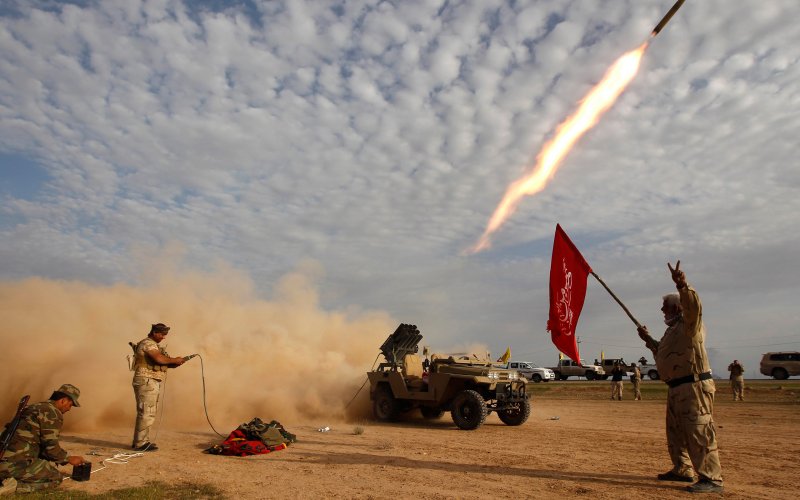By Michael Momayezi
The world was recently stunned by the newly brokered nuclear agreement between the U.S. and Iran, which was hailed by many as an historic victory of diplomacy and seemed to mark the reestablishment of Iranian-American interaction. While this may be true concerning formal diplomatic interactions, the two states have often found a way to collaborate in the Middle East when their interests align despite the absence of official diplomatic ties. Such was the case when Iran assisted the U.S. invasion of Afghanistan after 9/11, and such is the case now in Iraq and Syria in the fight against ISIL.
Iran’s involvement has been most noticeable and direct in Iraq, a country of deep strategic importance to Iran and a former threat to its security during the Iran-Iraq War in the 1980s. Iran’s Foreign Minister Mohammad Javad Zarif asserted last year in Baghdad that “Iran regards Iraq’s security as its own.” Similarly, the Obama administration claims that ISIS in both Iraq and Syria poses a serious national security threat to the United States, justifying its increased intervention against it.
While both Iran and the United Stated have vested interests in seeing ISIL fail in Iraq, collaboration between the two states, despite its effectiveness, can best be described as unofficial and awkward. Officials on both sides have repeatedly recognized the importance of the role the other has played in the fight against ISIL, yet they deny any deliberate partnership. U.S. Secretary of State John Kerry, for example, stated, “If Iran is taking on ISIL in some particular place…the net effect [will be] positive. But that’s not something we’re coordinating.” Iran has also made several moves to subtly show their support for American advances in Iraq, one of which is largely cutting back on its condemnation of American intervention in the region.
On the ground in Iraq, direct communication between Iran and the United States does not officially exist. Rather, the two states communicate and collaborate through different Iraqi military officials. This is done in order to ensure that American and Iranian moves against ISIL such as airstrikes do not inadvertently hurt the other party. Additionally, American troops in Iraq, who help train Iraqi security forces, and an Iranian-backed militia are sharing a base in Iraq’s Anbar province.
Much of the reluctance to officially work together may stem from the long history of animosity and suspicion between Iran and the U.S. Even today, Iran refuses to release four American hostages. It would hardly look good for the Obama administration to be seen in the public eye as collaborating with an enemy. In Iraq, this hesitance also comes from the fact that Iraq has been the bloodiest site of Iranian-American conflict, beginning with the American support of Saddam Hussein in the Iran-Iraq War. Even more, the aforementioned base in Iraq is currently being shared with the Iranian-backed Kataib Hezbollah, which killed more than a thousand American troops in the American Iraq War.
More recent examples of suspicion between the two states have also hindered more explicit partnerships against ISIL despite recent strides on the international diplomatic scene. In May, the Iranian Revolutionary Guard Commander Qassem Soleimani stated after the fall of Ramadi in Iraq, “Today, no one stands to take up the fight against this dangerous phenomenon (ISIL) but the Islamic Republic”. While some view this remark as a way of compelling the United States to take greater action against ISIL, others view it as a means of Iran to convince the U.S. that Iranian advances in ISIL-controlled territories are not expansionary but crucial to the fight against ISIL.
Indeed, Iran’s perceived expansionary goals have been of great concern to most critics of any Iranian-American collaboration in the region. ISIL in Syria, unlike in Iraq, poses no existential threat to Iran, so both Iranian citizens as well as the international community question the country’s motives and involvement in Syria. Iran’s financial and military aid to the Assad regime is viewed by many American officials as a means to expand Iran’s sphere of influence, offering it a gateway to the Mediterranean as well as a secure supply route to Hezbollah in Lebanon. Therefore, the states’ collaboration in Syria is much less likely because U.S. policymakers worry that Iranian intervention now would increase its regional influence after the fall of ISIL in the future.
Adding to this complicated situation is the U.S. alliance with Israel, Iran’s sworn enemy. Not surprisingly, the most likely skeptic of any American-Iranian partnership is Israel’s Prime Minister Benjamin Netanyahu; the United States is Israel’s strongest ally while Iran is its biggest enemy. In an address to the U.S. Congress in March to display his disapproval of collaboration with Iran, Netanyahu portrayed Iran as “competing (against ISIL) for the crown of militant Islam” and as a state whose ultimate goal is to see a universal caliphate. While the old proverb “the enemy of my enemy is my friend” seems to be holding true at least partially in Iraq between the United States in Iran, for Netanyahu, “when it comes to Iran and ISIS, the enemy of your enemy is your enemy”.
Recent studies by University of Tehran political science professor Nasser Hadian, however, show a shift in mindset within Iran when it comes to foreign intervention. In his paper, Hadian demonstrates an internal movement towards a “pro-minimal engagement” camp, which advocates for a larger focus on the country’s internal affairs, and away from a “pro-stabilization” standpoint, which currently governs much of Iran’s external policies that justify the state’s intervention in other parts of the Middle East. As many supporters of minimal engagement gain ground with recent developments such as Assad withdrawing his troops from many parts of Syria, the external perception of Iran’s motives concerning the Middle East may improve. Coupled with confidence in the new nuclear agreement, the world may actually see more visible and direct Iranian-American cooperation to serve common interests in Iraq and Syria.
Photo credit: Thaier Al-Sudani/Reuters
